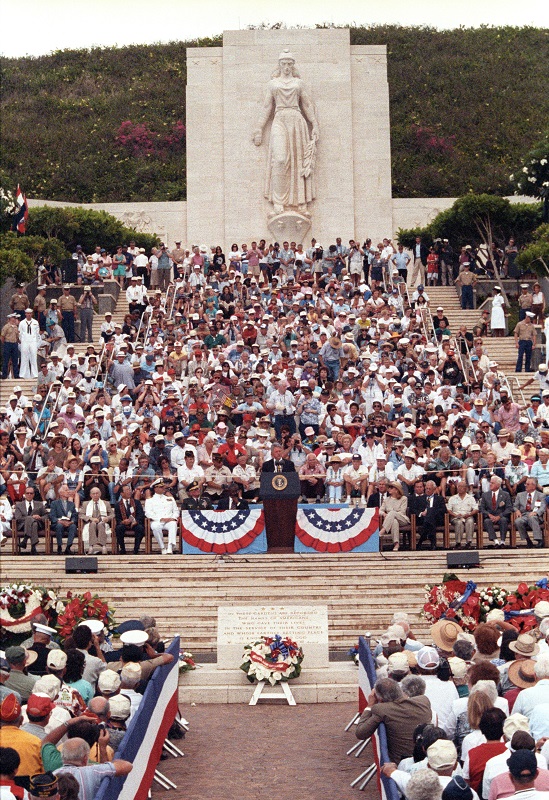
VA’s national cemetery system is far more expansive in terms of interments and properties than the three other federal agencies with similar responsibilities – Department of Army (DA), American Battle Monuments Commission (ABMC), and National Park Service (NPS). National shrines in the VA system are kept at the highest standards and visited by the public and distinguished visitors regularly. Yet, surprisingly, over the 160 years that many VA cemeteries have existed, U.S. presidents have rarely delivered speeches on these hallowed grounds.
There a few documented instances in the late nineteenth century and a storm canceled Barack Obama’s planned 2010 Memorial Day speech at Abraham Lincoln National Cemetery in Illinois. And while VA cemeteries display a plaque bearing the text of Lincoln’s Gettysburg Address, that famous piece of presidential oratory was delivered in what is now an NPS national cemetery. Otherwise, U.S. presidents have favored DA’s Arlington National Cemetery as a backdrop for Memorial and Veterans Day speeches and other special observances.
The scarcity of presidential appearances at VA cemeteries makes President William J. Clinton’s speech at the National Memorial Cemetery of the Pacific, more popularly known as the Punchbowl, on September 2, 1995, particularly noteworthy. Clinton visited the Punchbowl on V-J or Victory over Japan Day as part of a three-day commemoration celebrating the fiftieth anniversary of the end of World War II. Born in 1946, Clinton himself made history in 1992 when he became the first member of the post-WWII generation to be elected president. In its own way, the event at the Punchbowl marked the changing of an era.
Clinton’s 17-minute remarks were the last of an hour-long ceremony held on the steps of the ABMC’s Honolulu Memorial within the cemetery, described by VA Secretary Jesse Brown as a “vast and beautiful place of rest, like a cradle dropped from heaven [that] gently holds those who paid the ultimate sacrifice.” A crowd of some 6,500 attended, many of them World War II Veterans. They began gathering among the 33,000 graves decorated with American flags as early as 5 a.m. in a drizzling rain. In his address, Clinton focused on the sacrifices of the WWII generation and progress they made possible for American society:
It is only fitting that here in the middle of the ocean, whose name means peace, the place where WWII began and ended for America, that we mark the wars’ end and honor the men and women who saved our world. We owe it to the World War II generation to remember, but we owe them more. For just as freedom has its price, it also has its purpose. To enable all people to live up to their God given potential and to continue the march of human progress.
Toward the end of the speech, President Clinton requested that all WWII Veterans in the audience stand or wave a hand to be recognized. The camera panned across the crowd as hundreds rose to their feet, many wearing the medals they had earned for their service, and the drumbeat of applause sounded in the air. One of the Veterans so honored, Navy Captain Jim Daniels III, who figured prominently in Clinton’s speech, died nine years later and was laid to rest in that very cemetery, in Section CT4-Q, Row 100, Site 153.

View the full ceremony on C-SPAN. President Clinton’s remarks begin at 25:06 and conclude at 41:30.
Note: The WWII generation is rapidly disappearing. The number of Veterans who served in the war has fallen from around one million in 2015 to 240,000 in 2022.
By Richard Hulver, Ph.D.
Historian, National Cemetery Administration
Share this story
Related Stories

History of VA in 100 Objects
Object 96: Postcard of Veterans Vocational School
In 1918, the government created the first nationwide vocational training system to help disabled Veterans acquire new occupational skills and find meaningful work. Over the next 10 years, more than 100,000 Veterans completed training programs in every field from agriculture and manufacturing to business and photography.

History of VA in 100 Objects
Object 95: 1840 Census of Pensioners
In a first, the 1840 census collected data on Veterans and widows receiving a pension from the federal government. The government published its findings in a stand-alone volume titled “A Census of Pensioners for Revolutionary or Military Services.”

History of VA in 100 Objects
Object 94: Southern Branch of the National Home
The Southern Branch of the National Home for Disabled Volunteer Soldiers opened in Hampton, Virginia, in late 1870. The circumstances surrounding the purchase of the property, however, prompted an investigation into the first president of the National Home’s Board of Managers, Benjamin Butler.


